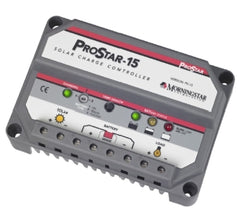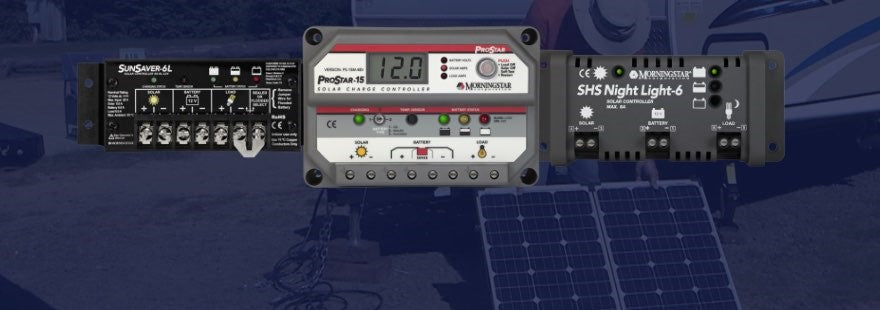How to Select a Solar Charge Controller Based on Your Needs
A solar charge controller is a vital component of any solar panel system. But how does a charge controller work? It helps to properly charge your batteries, giving them as long a life as possible. When choosing your new solar charge controller, there are a few things you’ll need to keep in mind in order to get the best fit for your system.
What is a Charge Controller for Solar Panels?

Charge controllers for solar panels, also known as charge regulators, manage the voltage and/or current in order to keep the batteries from overcharging. Your typical 12-volt (V) panels put out between 16 and 20V. Without regulation, the batteries will be permanently damaged as most only need around 14 to 14½V for a full charge.
Charge controllers aren’t always needed when using smaller, trickle-charge solar panels. If your panel puts out 2 watts or less per 50 battery amp-hours, you won’t need a charge controller. However, using one can make for a smarter solar panel system — no matter the size.
The following are some of the core functions of a solar panel charge controller:
- Manages how much power is drained from the battery, preventing over-discharging
- Ensures the battery bank does not overcharge
- Prevents battery-stored electricity from seeping back into the solar panels
- Extends battery life by regulating power according to the battery’s state of charge
- Disconnects loads through the low-voltage disconnect (LVD) feature in the event of a low battery state of charge, then reconnects loads once the battery is charged again
How Does a Solar Charge Controller Work?
A solar charge controller regulates the current into the battery by using the battery’s designated charging set points. The manufacturer of your battery should specify the voltage level (set point) for each of the three stages of battery charging (bulk, absorption and float).
Your charge controller will feed the highest current during the bulk stage until the voltage level rises to the bulk stage set point. Then, the battery will be about 80 percent recharged and the solar charge controller will reduce the current until it reaches the absorption set point. The charge controller will then drip enough current to keep your battery’s voltage at its float set point.
PWM Vs. MPPT Solar Charge Controller Options
When it comes to the various types of solar charge controllers, there are typically two options available: pulse width modulation (PWM) and maximum power point tracking (MPPT). These two types are extremely different in terms of the way they operate.
A PWM charge controller is used with smaller solar panel systems and thus tends to cost less. An MPPT charge controller is used with larger solar panel systems — and is overall more advanced and efficient; therefore, it is usually more expensive.
Let’s take a more in-depth look at the two types of solar charge controllers to help you make an informed buying decision.
PWM Solar Charge Controller
A PWM solar charge controller is considered the standard. A simple design, this affordable option works by slowly reducing the amount of power that goes into your battery as it approaches capacity. Once the battery is full, the charge controller will maintain a trickle, regularly supplying a small amount of power to keep the battery topped off.
Keep in mind that with a PWM charge controller, your solar panel system and RV or boat will need to have matching battery voltages. PWM controllers are typically better suited for smaller systems with just a few low-voltage panels and a small battery.
MPPT Solar Charge Controller
An MPPT solar charge controller provides similar switch-like protection to that of the PWM type, reducing the power flowing to your battery as it nears capacity. How this option differs from that of the PWM is that it offers the ability to pair non-matching voltages from panels and batteries. The MPPT controller works by adjusting the input in order to bring in the maximum amount of power possible from your system. In addition to this, an MPPT controller can also vary its output power to match the battery’s voltage.
MPPT charge controllers are often more efficient than PWM controllers and can more effectively utilize the full power of your solar panels. But this can come with a much higher price tag than that of the PWM solar charge controller.
How to Select a Solar Charge Controller
An MPPT solar charge controller is no better or worse than a PWM solar charge controller. Selecting the best one is all about finding the right option for your solar panel system. Consider your battery type and your system’s voltage and current.
Some of the best charge controllers on the market are those from MidNite Solar and Morningstar — each known for offering reliable and affordable products that last.

MidNite Solar charge controllers offer unparalleled reliability, functionality and pure power. Each charge controller comes with high-quality features and streamlined menus that make this brand a favorite among solar panel users.

Morningstar solar charge controllers are unique in that they’re built from the inside out, creating products that last more than twice the industry average in terms of operating life. Through the use of advanced technology, Morningstar has created some of the most sophisticated charge controllers on the market today.
Shop Solar Charge Controllers and More with Boat & RV Accessories
Browse our vast selection of solar panel charge controllers and accessories from brands like MidNite Solar, Morningstar, Samlex and more. At Boat & RV Accessories, we carry only new, top-of-the-line products from the brands you trust. Have a question or need additional information? Reach out today — we’re here to help!

